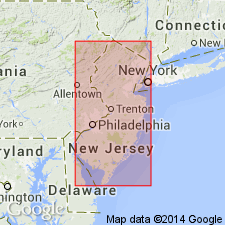
- Usage in publication:
-
- Pequanac shale*
- Modifications:
-
- Named
- Dominant lithology:
-
- Shale
- AAPG geologic province:
-
- Piedmont-Blue Ridge province
Summary:
Pequanac shale. Introduced to replace "Monroe shale" [preoccupied] of reports of the New Jersey Geol. Survey. Extensively developed along upper Pequanac [Pequannac] River. Thickness 1,000 feet. Overlies Kanouse sandstone. Contains Hamilton fossils.
Source: US geologic names lexicon (USGS Bull. 896, p. 1638).

- Usage in publication:
-
- Pequanac shale†
- Modifications:
-
- Abandoned
- AAPG geologic province:
-
- Piedmont-Blue Ridge province
Summary:
Cornwall shale having been published in 1907, as a name to replace "Monroe shales" in New York, the name "Pequanac" was in 1914 (USGS Raritan folio, no. 191) discarded in favor of Cornwall shale, now [ca. 1938] in use in both States.
Source: US geologic names lexicon (USGS Bull. 896, p. 1638).
For more information, please contact Nancy Stamm, Geologic Names Committee Secretary.
Asterisk (*) indicates published by U.S. Geological Survey authors.
"No current usage" (†) implies that a name has been abandoned or has fallen into disuse. Former usage and, if known, replacement name given in parentheses ( ).
Slash (/) indicates name conflicts with nomenclatural guidelines (CSN, 1933; ACSN, 1961, 1970; NACSN, 1983, 2005, 2021). May be explained within brackets ([ ]).

